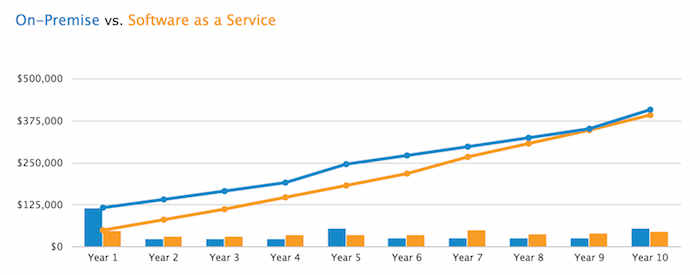
Tax compliance and enterprise digital transformation: Why your DX strategy should include cloud
With the Government directive of e-invoicing under Goods and Services Tax compliance for businesses in India, automated solutions on cloud are becoming top priorities under every CXO’s digital transformation (DX) strategy. This paper discusses the crucial need to include tax compliance as part of that transformation, regardless of a company’s volume or format of transactions. As DX gains momentum, it is bound to become ubiquitous, moving beyond information technology and modernizing operations on a holistic level.
Making the transition from on-premises to cloud can be challenging and although companies are eager to make the transition, they’re taking it slow. In a 2018 study by IDG (International Data Group) on the future of digital business, it was found that of the 89 percent of organizations that planned to adopt a digital-first business strategy, only 44 percent have fully implemented the approach.
However, the transition is in motion. A recent report by LogicMonitor suggests that cloud technology will take precedence over on-premises technology in the near future.
So, where does India fit in?
Although gradual, digital transformation is here to stay and isn't going away anytime soon. In fact, a report by Oracle predicts the migration of 80 percent of all enterprises to cloud by 2025. Over the last two years, public cloud services in India saw phenomenal growth reaching $1.8 billion in 2017, up from $1.3 billion in 2016. According to NASSCOM, cloud technology is seeing an upward trajectory and is estimated to reach $7.1 billion in the next three years. This growth is 10 times of what we have seen in 2012. India has been impacted by the trend of cloud computing in the most progressive way, as the cloud is rapidly altering the IT landscape. Organizations have accepted that growth is uncertain without the cloud and companies are allocating huge shares of their revenues for upcoming cloud innovations.
Where do finance, accounting, and tax compliance fit into the picture?
Enterprise organizations are steadily moving towards automating operations of various functions. From manufacturing, warehousing, sales, marketing and supply chain management to customer care, every detail from the first to the last mile is taken care of using automated solutions. So why should finance, accounting, and tax Compliance be left behind? More important, how can they also be integrated into the DX process to ensure they are in sync with government mandated processes like e-invoicing under Goods and Services Tax in India?
For a DX strategy to work in any organization, finance and IT departments need to be working in tandem. Finance has a lot to gain from automated, error-free solutions. Considering that finance can no longer work in isolation, more and more enterprises are introducing finance teams to cloud and automated solutions. Leading research agency Gartner has predicted that within the next couple of years one-third of enterprise organizations in India will prefer cloud-only strategy as part of their DX exercise.
Making the transition
Goods and Services Tax (GST), the major indirect tax in India, banks on the fulfillment of compliance obligations with the help of technology. Compliance has been at the core of GST because it was envisaged as a simplified tax policy compared to India’s previous fragmented tax structure. However, when the Goods and Services Tax was first introduced in India in 2017, organizations reported transition issues that hampered the adaptation process. The introduction of the e-way bill added to the chaos.
More businesses are opting for the Software as a Service (SaaS) delivery model to assist with their digital transformation strategy and benefit from the centrally hosted productivity software on a subscription basis. Here are some benefits of managing tax compliance through SaaS platforms:
Real-time updates
For tax compliance, a SaaS cloud solution connects to the business system already in use and automatically updates tax data in real time whereas an on-premise solution requires tax data to be updated manually.
Transparency
Furthermore, a SaaS cloud solution allows for improved transparency and access when it comes to GST compliance and e-way bill automation. Access to transaction data anytime, anywhere is one of the most significant and sought-after benefits of cloud. Access can also be managed based on user roles.
Security
Migrating from on-premises to cloud takes planning. In India, the security of sensitive transaction data is a major concern for enterprises considering this transition. In retrospect, on-premises solutions cannot guarantee data security. In fact, on-premise security is only as reliable as the security policies enforced at an organization. Cloud service providers fully understand that thousands of customers entrust their data security to them and therefore are required to meet the highest security standards.
Agility
Cloud can enable organizations to prepare for future needs while modernizing their current technology base. Faster application implementation and deployment is yet another cherished feature of the cloud. Disaster recovery can also be faster with cloud compared to an on-premises solution.
Cost
When it boils down to pricing, direct cost as well as indirect cost must be taken into consideration. Direct cost includes the cost of owning or licensing data center equipment, whereas indirect cost encompasses the cost of third-party service, maintenance and management, training, and policy. An on-premises solution proves to be costly whenever there’s a need to scale up because it will warrant additional servers and all the necessary hardware as well as software installation required. Most cloud solutions have a subscription model wherein pricing is based on the number of transactions or number of users. On-premises solutions often prove to be expensive in the long run. The chart below shows total costs of ownership over 10 years for both cloud-based and on-premises software.

Implementation and go-live
On-premises solutions typically take a long time to implement, thereby disrupting an organization’s chain of activities at some level or other. Implementation of a SaaS solution tends to be easier since it doesn’t disrupt the entire organization’s activities. SaaS integrations, like those offered by Avalara, are designed to be seamless and connect quickly and easily into multiple ERP, accounting, and ecommerce systems. On-premises solutions are typically less agile, offering limited integrations with only a few enterprise platforms. Managed services and support can actually set things in motion for automation.
Avalara as Application Service Provider (ASP) in India, deliver businesses the power to meet timely GST compliance obligations while pushing their boundaries and ensuring growth. Avalara helps organizations transition their tax filing and returns preparation into the digital age with GST compliance suite.
For more information on GST compliance, visit www.avalara.com
Avalara helps businesses of all sizes get GST return filing, e-way bill generation and e-invoicing right with cloud-based GST compliance solutions in India. Goods and Services Tax (GST) rates, rules, and regulations change frequently. Although we hope you'll find this information helpful, this blog is for informational purposes only and does not provide legal or tax advice.









